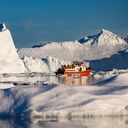Greenland Ice Sheet lost 20% more ice mass than thought

Scientists may have underestimated the amount of Greenland Ice Sheet melting since 1985 by as much as 20%, a new study found.
Why it matters: Such an underestimate of Greenland ice mass loss indicates a heightened risk of shifts in ocean currents and global weather patterns, the study notes.
- To date, melting of the Greenland Ice Sheet is the biggest contributor to global sea level rise.
Zoom in: The study focuses on glacier calving retreat, which means ice lost at the edges where glaciers meet the sea.
- According to the new research, published in the journal Nature, since 1985, the Greenland Ice Sheet has lost about 5,091 square kilometers (1,965 square miles) of area due to its retreating calving front, which amounts to about 1,034 gigatons of ice that has slid into the sea.
- The study combines 236,328 manual and AI-generated observations of glacier terminus, or end, positions with a model to capture ice flow. The researchers used this to provide insights into the monthly aerial extents of the entire ice sheet between 1985 and 2022.
Of note: Because much of this ice is already floating in the sea, its melt does not directly contribute to sea level rise, but it threatens to upend ocean currents.
What they found: The data indicates that the rate of ice retreat stayed steady until the 1990s, with a faster rate of loss since 2000.
- Every region of the ice sheet shows area and mass loss during the period.
- The researchers used observations from 203 marine-terminating glaciers and four glaciers that end on land, which comprise 90% of the total mass of the ice sheet.
- Only one glacier saw gains in mass during the period, and it was small compared to the losses elsewhere.
The bottom line: "Nearly ever glacier in Greenland has retreated over the past few decades, and in a warmer world, we posit that the glaciers that are most sensitive to changes on seasonal timescales will show the greatest sensitivity to future climate change," the study finds.
The intrigue: The two glaciers that have lost the most mass — Jakobshavn Isbrae near Ilulissat on the west coast and Zachariae Isstrom in northeastern Greenland — vary considerably throughout the seasons, influenced by ocean currents and water temperatures.
- Scientists found that glaciers' seasonal variations is the best predictor of long-term mass loss.
- "It is clear that a widespread forcing mechanism has touched nearly every glacier in Greenland over the past few decades and has most considerably affected the glaciers that show sensitivity to environmental change on seasonal timescales," the study states.
- The study's authors claim they capture more than 1,000 gigatons of ice loss that has not been included in previous ice mass loss studies, in part because it can't be detected by satellites and other measuring technologies.
Between the lines: The melting is having far-reaching effects, to which this new study calls attention.
- With more freshwater going into the North Atlantic Ocean since 1985 than previously known, it could explain some of the weakening observed in the vital Atlantic Meridional Overturning Circulation (AMOC), part of which includes the Gulf Stream.
- "There is some concern that any small source of freshwater may serve as a 'tipping point' that could trigger a full-scale collapse of the AMOC," the study warns, noting the widespread impacts that would have on weather patterns and food security.
What they're saying: "We have known for a while that many of the models projecting ice-sheet evolution have difficulty in simulating the recent changes," climate scientist Richard B. Alley of Penn State told Axios via email. Alley was not involved in the new study.
- "It has been less clear what parts of the data should be the target for improvements," he said, noting this new data set might indicate "a much better target" for testing models.
- Ruth Mottram, a researcher at the Danish Meteorological Institute, who also was not part of the new study, said the techniques used in the study are novel.
- "There is a huge amount of machine learning based insights coming into glaciology, and Earth science in general, and I think this is a nice demonstration of how we can use statistics on big, high quality datasets to really learn something about the world," she told Axios.
As for the study's results, she said: "They show pretty convincingly that seasonal dynamics — that is, how far a glacier moves forward in winter and then calves back in summer, is the most important determinant on how much ice the glacier is losing over the study period," she said.
- "Essentially, the more dynamic a glacier is on a seasonal timescale, the more sensitive it is to climate change."